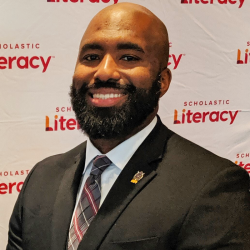
Unprecedented: a term we’ve heard over and over again during these unforeseeable times.
As a school leader, you receive training that prepares you for how best to be an instructional, systemic, and community leader. We review different scenarios, assess responses, review best practices, and develop our quick thinking acumen to handle unpredictable situations. I do not think there is a school leader in the country, however, that was “prepared” for how a global pandemic would completely shift our educational system.
If your school has implemented Project Based Learning, this halt in normal everyday instruction more than likely impacted any plans or progress for your program. On the other hand, these times have shown the resilience of our staff and students in unimaginable ways.
The power of technology continues to make our world smaller, thrusting new resources into our instructional world. Our teachers dove into this uncharted territory and are doing a phenomenal job with this once-in-a-lifetime hand they’ve been dealt.
So as school leaders, how do we support our staff in maintaining and/or growing our PBL learning environments in a virtual, socially distanced world?
I recommend starting with the following 4 steps.
1. Consistent Check-Ins
The online learning world can be an isolated place. Departments, schools, and districts are doing their best at providing virtual professional learning communities and professional development opportunities, but these experiences do not always lend themselves to the informal brainstorming that happens naturally when educators plan together or even have random conversations in the hallway.
To help alleviate the sense of isolation, schedule check-ins with your teachers. If you are already holding collaborative planning sessions, make the check-ins a separate, more informal meeting time where ideas, plans, and goals are bounced around. Create that virtual meeting space for your staff by being consistent, giving a listening ear, contributing ideas, and connecting colleagues that may have similar visions. A true PBL experience is rooted in authenticity and as a school leader, we have to intentionally create opportunities for authentic conversations to occur, no matter the setting.
2. Sharing Resources
If there is one thing the internet is not short of right now, it’s educational resources. In fact, one could say it’s overwhelming. So I cautiously list this point, but it’s important. This is why I have it listed after check-ins. Once you’ve heard from your teacher about PBL units they’re planning, try finding relevant resources that could contribute to it. Assist with identifying outside organizations and experts that can enhance the project’s desired outcome.
Read articles. Investigate tools. Be a filter for your teachers, who are already receiving plenty, and share with them the best, most fitting resources that you have taken the time to investigate and recommend. PBLWorks has recently published several articles, blogs, and tools that I have shared with my teachers. The virtual trainings that are offered are amazing for learning about the practice of Gold Standard PBL as well as networking with colleagues from all over the country (and world).
3. Active Participation
Project Based Learning is about being “all in.” A major part of developing a true wall-to-wall PBL culture is involving everyone in the building with the experience. If your school is in the early stages of implementation, thinking about starting a PBL program, or possibly a few years in with still reluctant participation, shifting to a virtual/hybrid/non-traditional setting due to this pandemic could possibly set back your progress.
To keep your PBL effort moving forward, it is essential that whatever plans your teachers collectively develop with their students, you as a school leader are right there participating with them. Especially right now. When students are in small groups working, join the group and contribute. If classes need an authentic audience to present to, find willing participants and also participate. Create planning/collaborating time, specifically for PBL, and join the sessions, supporting and/or contributing when appropriate. Your presence as a leader IN the work shows your staff and students that you believe in this program and their efforts. The vulnerability that comes with being side by side with your school community in a new learning environment is invaluable and will lead to authentic, unique, treasurable experiences.
4. Creative Public Sharing
One of the great things about PBL is the opportunity for students to share their public product with stakeholders, community and industry leaders, family members, other educators, and friends. As a leader, think about ways to virtually gather these parties for an opportunity for students to authentically share their hard work. It could be a presentation to the local city government, the board of a museum, a neighborhood committee, or whatever group is directly impacted by the problem or issue students addressed.
To be a leader in a PBL school means to be willing to “get in the thick of things” right along with your staff and students—which does not change in these “unprecedented” times.
Whether we return to what we consider normal, or adopt a new normal, we as leaders are still expected to lead. Leading a PBL school requires just a little bit more from us, especially during a pandemic, but is absolutely worth it when we think about the impact it will have on students and your school community.

